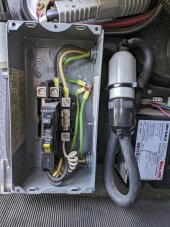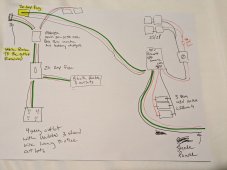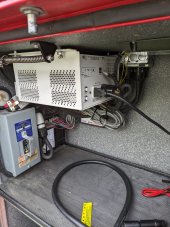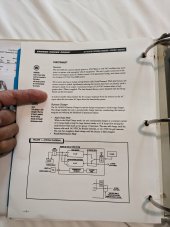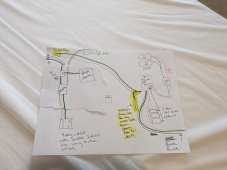Yes, tested continuity with unit off, no line in or line out connected. solar array disconnector off, battery breaker off.
No continuity between neutral and ground. The only continuity is between the line in ground and the line out ground.
Unit does not bond N-G then.
Most likely SS had it built with the screw removed. I went back and watched that video you linked hoping it would show the location of the screw he removed but it didn't. Do not test like that YouTuber, he is doing it incorrectly and doesn't know what he is doing.
You can search around to find a video where it shows the bonding screw location. A screw can be sourced locally or have SS send you one. Open up the unit and see if the bonding screw is present. If there is a screw in the correct location, the unit is defective as the bonding relay is not working correctly. If a screw is not present, install the screw and retest for continuity between N and G. If you have continuity, then you are good to go. The unit will bond N-G under inverter power and disable the N-G bond on shore power using the relay.
There is continuity between both grounds and the case of the inverter. No continuity between the either of the grounds or the case and the skin of the vehicle.
You will need to bond the skin and chassis of the vehicle to either the EGC busbar in the electrical panel or to the inverter. Most likely the electrical panel contains this bond, check for continuity between the EGC grounding busbar in the electrical panel and the vehicle skin and chassis. If this checks out, all that is needed is an EGC ran between the inverter and electrical panel with L and N.
The inverter and batteries are secured in a plywood box inside the interior of the ambulance.
Admittedly I got the Growatt because it was inexpensive. I am not entirely confident that I will be able to effect a return as their customer service is shit and I bought the inverter in Jun 2022, over a year ago. I will reach out and try to return it, but frankly I don't want to get jacked around with the waiting game. So I could just order another inverter from Watts-247, but Growatt has left a bad taste in my mouth.
It isn't Growatt's fault, it is probably the build spec from SS.
Lets imagine, that right now I buy another 48V Growatt SPF 3000TL LVM from Watts247 that works correctly. Then at some later date, I move these inverters out of the ambulance, and put them in a 100% off grid cabin is it forseeable to be able to remove the case covers and add and remove ground screws to safely use them in tandem for 220v, even if they were purchased from different distributers?
It would actually work out very well as you need one inverter bonded and the other not bonded. That is how I run my LV6548's, one inverter still has the screw and the other doesn't. You want the source to be bonded.
To clarify. The vehicle is 2000 Wheeled Coach Ambulance. There is currently a shore power plug, that I plan to delete and make a connection to the AC output of the Growatt. I was hoping to make a self contained system with the Growatt, solar and batteries that could just power the existing ambulance as its own 'mobile shore power'.
View attachment 162387
Looking at this wiring diagram I'd question leaving the Vanner unit connected. The Vanner is rated at 1050 watts. I looked for a pass thru rating, my assumption is pass thru is 1050 watts. It would be best to directly wire the Growatt to the electrical panel or wire the electrical panel with the shore power cord allowing a choice between the Vanner output, the Growatt or shore power. If you do go with the shorepower cord to the electrical panel, you could use a generator bonding plug for use with the Growatt. This would not allow for battery charging on shore power unless you add another cord to the Growatt.
Personally, I'd hardwire the Growatt to the electrical panel, then add a receptacle to the Vanner for a backup power source so a shore power cord could be plugged into it. Run a shore power cord to the Growatt input so the transfer switch will switch automatically between inverter power and shore power when plugged in. This allows battery charging with the Growatt.
Or just remove the Vanner, sell it or repurpose it if you don't want the extra weight and free up space.



